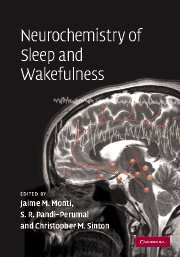Book contents
- Frontmatter
- Contents
- List of contributors
- Preface
- Acknowledgements
- Abbreviations
- I The neurochemistry of the states of sleep and wakefulness
- II The influence of neurotransmitters on sleep and wakefulness
- III Changing perspectives
- 10 Melatonin and its receptors: biological function in circadian sleep–wake regulation
- 11 Sleep regulatory factors
- 12 Adenosine and sleep–wake regulation
- 13 Prostaglandins and the regulation of sleep and wakefulness
- 14 Neuropeptides and sleep–wake regulation
- 15 Orexins in sleep and wakefulness: rodent models of narcolepsy–cataplexy
- 16 The relevance of experimental pharmacology to currently available sleep–wake therapeutics
- Index
- Plate section
13 - Prostaglandins and the regulation of sleep and wakefulness
from III - Changing perspectives
Published online by Cambridge University Press: 23 October 2009
- Frontmatter
- Contents
- List of contributors
- Preface
- Acknowledgements
- Abbreviations
- I The neurochemistry of the states of sleep and wakefulness
- II The influence of neurotransmitters on sleep and wakefulness
- III Changing perspectives
- 10 Melatonin and its receptors: biological function in circadian sleep–wake regulation
- 11 Sleep regulatory factors
- 12 Adenosine and sleep–wake regulation
- 13 Prostaglandins and the regulation of sleep and wakefulness
- 14 Neuropeptides and sleep–wake regulation
- 15 Orexins in sleep and wakefulness: rodent models of narcolepsy–cataplexy
- 16 The relevance of experimental pharmacology to currently available sleep–wake therapeutics
- Index
- Plate section
Summary
Introduction
Sleep substances
The humoral theory of sleep regulation, the concept that sleep and wakefulness are induced and regulated by a hormone-like chemical substance rather than by a neural network, was initially proposed by Kuniomi Ishimori of Nagoya, Japan, and independently and concurrently by the French neuroscientist Henri Piéron of Paris, in the first decade of the twentieth century. They took samples of cerebrospinal fluid (CSF) from sleep-deprived dogs and infused them into the brains of normal dogs. The recipient dogs soon fell asleep. Thus these researchers became the first to demonstrate the existence of endogenous sleep-promoting substances. However, the chemical nature of these sleep substance(s) was not identified. During the following 90 years, more than 30 so-called endogenous sleep and wake substances were reported by numerous investigators to exist in the brain, CSF, urine, and other organs and tissues of animals. For example, delta-sleep-inducing peptide, muramyl peptides, uridine, oxidized glutathione, and vitamin B12 have been proposed as endogenous somnogenic substances. The detailed account of these substances is described in an excellent treatise by Inoué (1989). During the early 1980s, Professor Jouvet and his colleagues in Lyon also found a sleep-inducing factor produced by the periventricular structures including the choroid plexus in the central nervous system (CNS) of cats (Bobillier et al., 1982; Jouvet et al., 1983).
- Type
- Chapter
- Information
- Neurochemistry of Sleep and Wakefulness , pp. 363 - 386Publisher: Cambridge University PressPrint publication year: 2008
- 2
- Cited by



